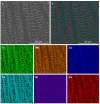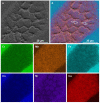Evaluation of Equiatomic CrMnFeCoNiCu System and Subsequent Derivation of a Non-Equiatomic MnFeCoNiCu Alloy
- PMID: 36984334
- PMCID: PMC10056590
- DOI: 10.3390/ma16062455
Evaluation of Equiatomic CrMnFeCoNiCu System and Subsequent Derivation of a Non-Equiatomic MnFeCoNiCu Alloy
Abstract
Investigation into non-equiatomic high-entropy alloys has grown in recent years due to questions about the role of entropy stabilization in forming single-phase solid solutions. Non-equiatomic alloys have been shown to retain the outstanding mechanical properties exhibited by their equiatomic counterparts and even improve electrical, thermal, and magnetic properties, albeit with relaxed composition bounds. However, much remains to understand the processing-structure-property relationships in all classes of so-called high-entropy alloys (HEAs). Here, we are motivated by the natural phenomena of crystal growth and equilibrium conditions to introduce a method of HEA development where controlled processing conditions determine the most probable and stable composition. This is demonstrated by cooling an equiatomic CrMnFeCoNiCu alloy from the melt steadily over 3 days (cooling rate ~4 °C/h). The result is an alloy containing large Cr-rich precipitates and an almost Cr-free matrix exhibiting compositions within the MnFeCoNiCu system (with trace amounts of Cr). From this juncture, it is argued that the most stable composition is within the CrMnFeCoNiCu system rather than the CrMnFeCoNi system. With further optimization and evaluation, a unique non-equiatomic alloy, Mn17Fe21Co24Ni24Cu14, is derived. The alloy solidifies and recrystallizes into a single-phase face-centered cubic (FCC) polycrystal. In addition to possible applications where Invar is currently utilized, this alloy can be used in fundamental studies that contrast its behavior with its equiatomic counterpart and shed light on the development of HEAs.
Keywords: high-entropy alloys; microstructure; multi-principal element alloys; solidification; transition metal alloys and compounds.
Conflict of interest statement
The authors declare no conflict of interest.
Figures















References
-
- Cantor B., Chang I.T.H., Knight P., Vincent A.J.B. Microstructural development in equiatomic multicomponent alloys. Mater. Sci. Eng. A. 2004;375–377:213–218. doi: 10.1016/j.msea.2003.10.257. - DOI
-
- Yeh J.-W., Chen S.K., Lin S.-J., Gan J.-Y., Chin T.-S., Shun T.-T., Tsau C.-H., Chang S.-Y. Nanostructured High-Entropy Alloys with Multiple Principal Elements: Novel Alloy Design Concepts and Outcomes. Adv. Eng. Mater. 2004;6:299–303. doi: 10.1002/adem.200300567. - DOI
-
- Otto F., Yang Y., Bei H., George E. Relative effects of enthalpy and entropy on the phase stability of equiatomic high-entropy alloys. Acta Mater. 2013;61:2628–2638. doi: 10.1016/j.actamat.2013.01.042. - DOI
-
- Vaidya M., Guruvidyathri K., Murty B. Phase formation and thermal stability of CoCrFeNi and CoCrFeMnNi equiatomic high entropy alloys. J. Alloys Compd. 2019;774:856–864. doi: 10.1016/j.jallcom.2018.09.342. - DOI
-
- Ma D., Grabowski B., Körmann F., Neugebauer J., Raabe D. Ab initio thermodynamics of the CoCrFeMnNi high entropy alloy: Importance of entropy contributions beyond the configurational one. Acta Mater. 2015;100:90–97. doi: 10.1016/j.actamat.2015.08.050. - DOI
Grants and funding
LinkOut - more resources
Full Text Sources

